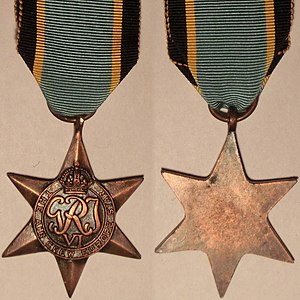Air Crew Europe Star
| The Air Crew Europe Star | |
|---|---|
 |
|
| Awarded by the Monarch of the United Kingdom and the Dominions of the British Commonwealth, and Emperor of India | |
| Country |
|
| Type | Military campaign medal |
| Eligibility | All Ranks |
| Awarded for | 60 days of operational flying |
| Campaign(s) | European Air Operations 1939–1944 |
| Clasps | ATLANTIC FRANCE AND GERMANY |
| Statistics | |
| Established | May 1945 |
| Order of wear | |
| Next (higher) | Arctic Star |
| Next (lower) | Africa Star |
| Related |
Atlantic Star France and Germany Star |
|
Ribbon bar without and with rosette |
|
The Air Crew Europe Star is a military campaign medal, instituted by the United Kingdom in May 1945 for award to subjects of the British Commonwealth for service in the Second World War, specifically Commonwealth air crew who participated in operational flights over Europe from bases in the United Kingdom.
Two clasps were instituted to be worn on the medal ribbon, the Atlantic Clasp and the France and Germany Clasp.
Altogether eight campaign stars and nine clasps were initially instituted for campaign service during the Second World War. On 8 July 1943, the 1939–1945 Star and the Africa Star were the first two of these Stars to be instituted. One more campaign star, the Arctic Star, and one more clasp, the Bomber Command Clasp, were belatedly added on 26 February 2013, more than sixty-seven years after the end of the war.
Only one of these campaign stars, the 1939–1945 Star, covered the full duration of the Second World War from its outbreak on 3 September 1939 to the victory over Japan on 2 September 1945.
No-one could be awarded more than five (now six) campaign stars and no-one could be awarded more than one clasp to any one campaign star. Five of the nine (now ten) clasps were the equivalents of their namesake campaign stars and were awarded for the same respective campaigns as those stars, to be worn on the ribbon of that campaign star of the applicable group which had been earned first. The maximum of six possible campaign stars are the following:
Since only the first of the Atlantic Star, Air Crew Europe Star or France and Germany Star to be earned could be awarded to any one individual, the possible Star and Clasp combinations for these three campaign stars are:
The strategic bombing campaign against German industrial cities, military installations and a wide variety of other targets continued throughout World War Two and made a decisive contribution to Allied victory. Although the Air Forces suffered significant losses of both men and aircraft, the campaign severely curtailed German industrial production.
The Air Crew Europe Star was instituted in May 1945 to commemorate flying operations from the United Kingdom over Europe and was intended primarily for award to air crew. Two clasps were instituted to be worn on the Air Crew Europe Star's medal ribbon, the Atlantic Clasp and the France and Germany Clasp.
British uniform regulations stipulated that no one person could be awarded more than one clasp to any one campaign star, and neither the Atlantic Star nor the France and Germany Star could be awarded to a recipient of the Air Crew Europe Star. Subsequent entitlement to either of these two stars was denoted by the award of either the Atlantic Clasp or the France and Germany Clasp to the Air Crew Europe Star. Regulations further stipulated that only the first clasp earned could be worn with the medal.
...
Wikipedia
